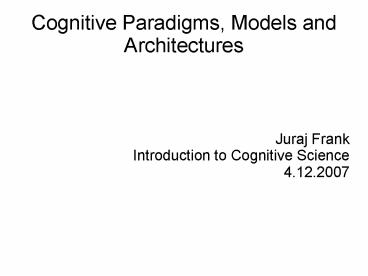Cognitive Paradigms, Models and Architectures - PowerPoint PPT Presentation
1 / 14
Title:
Cognitive Paradigms, Models and Architectures
Description:
embracing connectionist systems, dynamical systems, and enactive systems, all ... 'impasse' new state in new problem space sub-goal. new production rules ... – PowerPoint PPT presentation
Number of Views:128
Avg rating:3.0/5.0
Title: Cognitive Paradigms, Models and Architectures
1
Cognitive Paradigms, Models and Architectures
- Juraj Frank
- Introduction to Cognitive Science
- 4.12.2007
2
Paradigms of Cognition
- Cognitivist Approach
- cognition is a type of computation
- Emergent Systems Approach
- embracing connectionist systems, dynamical
systems, and enactive systems, all based to a
lesser or greater extent on principles of
self-organization
3
Cognitive Architectures
4
C The Soar Cognitive Architecture
- production (or rule-based) system that operates
in a cyclic manner, with a production cycle and a
decision cycle - universal sub-goaling
- 'impasse'
- new state in new problem space sub-goal
- new production rules
5
C Adaptive Control of Thought - Rational
6
E Global Workspace Cognitive Architecture
7
E Global Workspace Cognitive Architecture II.
8
E Self-Affecting Self-Aware (SASE) Cognitive
Architecture
9
H Kismet
- used to examine the role of emotion and
expressive behaviour in regulating social
interaction between humans and robots - an articulated anthropomorphic robotic head
- a total of 21 degree-of-freedom, three to control
the head orientation, three to direct the gaze,
and fifteen to control the robots facial features - goal to learn from people through social
engagement
10
H Kismet
11
(No Transcript)
12
Design principles for systems capable of
development
- architecture should address the dynamics of the
neural element - be able to effect perceptual categorization
- to have a physical instantiation
- to engage in some behavioural task
- to have a means to adapt
13
Conclusions
- a developmental cognitive system will be
constituted by a network of competing and
cooperating distributed multifunctional
sub-systems (or cortical circuits)? - a developmental cognitive architecture must be
capable of adaptation and self-modification - cognitive systems are anticipatory and
prospective - rehearse hypothetical scenarios
- mechanism to use this to modulate the actual
behaviour of the system - embodiment
14
Thank you
- Reference
- Vernon D., Metta G., Sandini G. A Survey of
Artificial Cognitive Systems Implications for
the Autonomous Development of Mental Capabilities
in Computational Agents. Evolutionary
Computation, IEEE Transactions on, Vol. 11, No.
2. (2007), pp. 151-180.































